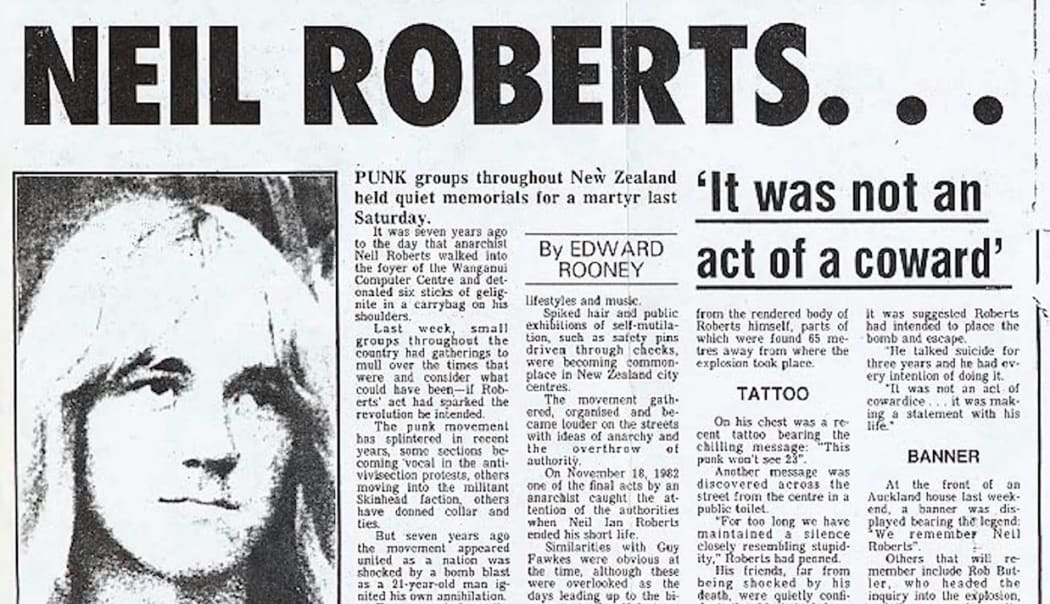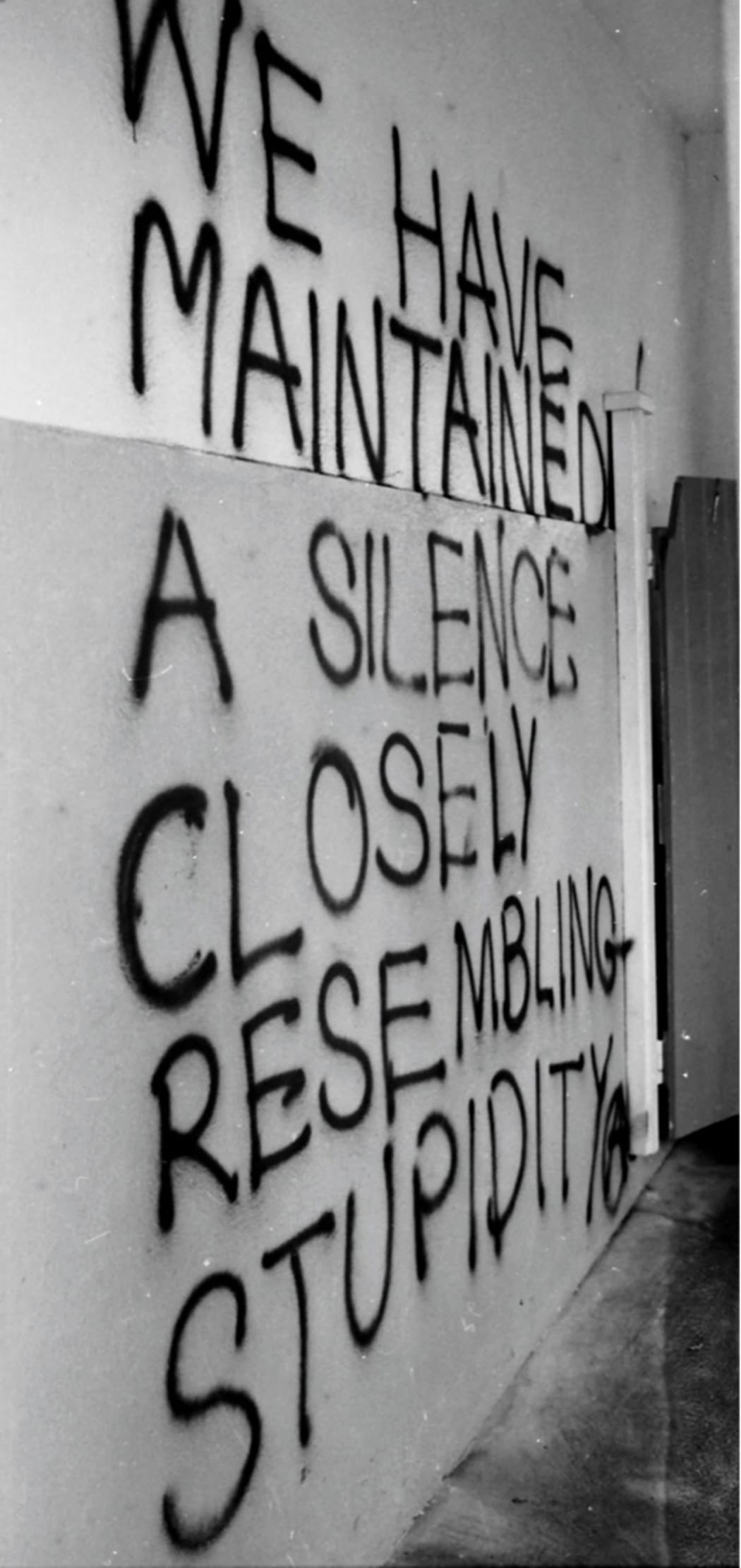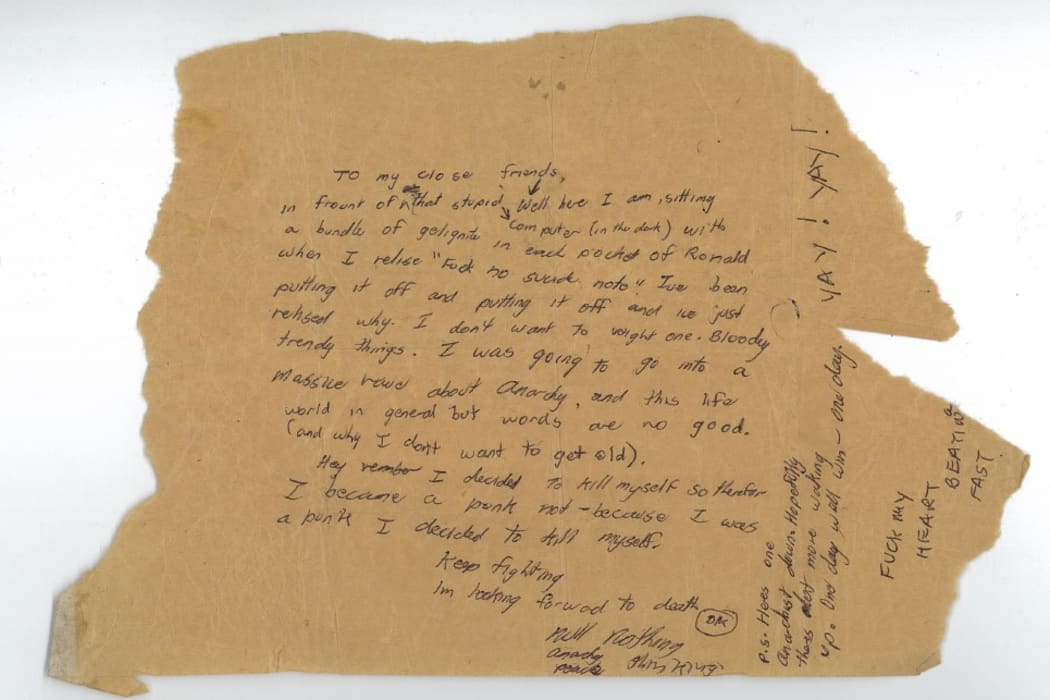Suicide bombing is seen by most New Zealanders as a terrorist act that happens overseas. But 33 years ago, an anarchist punk blew himself up trying to destroy “New Zealand’s Big Brother”.
When Neil Roberts blew up part of the Wanganui Computer Centre, killing himself instantly, a policeman told media: “they’ll be finding bits of him for days”.
His final words, scribbled haphazardly on a piece of cardboard outside a public toilet, told friends to keep fighting. “Heres [sic] one anarchist down. Hopefully there’s a lot more waking up. One day we’ll win - one day.”
November 18 marked 33 years since the young Auckland chef-turned-punk walked up to what media had dubbed “New Zealand’s Big Brother” just after midnight, and placed explosives at its doorsteps in the hope of destroying the symbol of surveillance society in 1982.
The Wanganui Computer Centre was a groundbreaking development in data surveillance and was the go-to for all criminal records - even parking tickets.
Earlier, Roberts spraypainted the words “we have maintained a silence closely resembling stupidity” on the toilet block, accompanied by the anarchy-is-order symbol (“A” circled by an “O”) and the words “anarchy, peace, thinking”.
The aftermath of the event was full of media and politicians seeking to paint Roberts as a misguided misfit. “Cheerful Punk’s Date with Death” was splashed on a Wellington paper, and police stirred up hype about a potential anarchist terror group.
A bulletin on Radio New Zealand at the time said: “the force of the blast was such that police were initially unable to determine the sex of the person killed” and Roberts’ body parts were scattered 65 metres.
A generation have grown up getting used to digital surveillance and unaware of the death of Roberts and the statement he was trying to make.
Recently it was revealed police obtained bank information from Westpac bank about journalist Nicky Hager without any court order while preparing to raid his house.
Next month, Wellington City Council will start trialling cameras with sensors that can detect screaming, paint fumes from graffiti and and sense groups that may end up fighting.
This comes off the back of revelations the GCSB are spying on Pacific neighbours and an era where emails, texts and Facebook messages are stored in US data banks.
All this surveillance is meant to be for our own good. In an age where terror threats are increasing, it makes sense, the government argues, to be monitoring individuals for the security of a nation, but at what cost?
Most of us survived the feeling of impending doom that this particular era of world politics created by getting drunk, out of it and partying hard.
***
Roberts was the mild-mannered son of wealthy Aucklanders. Attempts to reach out to family members have been unsuccessful; the following is a description built up from friends, fellow punks and an ex-girlfriend.
A striking young man, small in physique, always decked in black - particularly a big jacket his mum made him - he went to Auckland Grammar, left school in favour of a chef’s apprenticeship and bought a house.
In 1981, aged 21, Roberts worked as a chef. Then punk came along “and he was like fuck thaaaat” to his straight-laced ways, says ex-girlfriend Lizette Twisleton.
Never wore shoes, always wore dark eyeliner. He changed his name to Null. He often dyed his hair or shaved his head - sometimes just sporting a green triangle on his scalp. He would shave his eyebrows too. Lots of pins, chains, handwritten badges such as “drug-takers against the bomb”.
He listened to The Sex Pistols, Ian Dury and the Dead Kennedys and would hang out at Barnacle Bill’s off Queen St or at the university, despite not being a student.
He was a keen gardener, had wild parties at his house - where freshly crowned punks drunkenly painted the walls with slogans and symbols.
He believed in anarchy in its purest form: no law, free society. He wouldn’t harm a fly, always smiling. “Not a nutter by any stretch of the imagination,” says a former punk rocker.
“This punk won’t see 23 - no future” was tattooed on his chest, words inspired by English punk Ian Curtis. This part of his body, found among debris, was later used by police to rule the death a suicide.
“Auckland in the 80s was a bleak place,” says Kathy Ramsay, a friend of Roberts’ who saw him days before he died (they were at a party, he dressed in a black rubbish bag - “not that unusual in this time and place”.).
“The inner-city could be a violent place, we had a very restrictive government and, on the world stage, it looked possible that either America or Russia would blow the world up.”
There wasn’t much in the way of fun - books, comics and music imported from overseas were pricey and took months to arrive. However, there was a thriving music scene, where Ramsay found herself a loosely-knit tribe of bootboys, bootgirls and punks. Among them was Roberts.
She recalls him being punched by one aggressive bootboy: “Neil just stood there looking sad, saying ‘Why do you need to hit me?’”
He was one of the few people who talked in-depth with Ramsay about what life meant.
“Most of us survived the feeling of impending doom that this particular era of world politics created by getting drunk, out of it and partying hard.”
Friends believe the catalyst for Roberts’ bombing was the 1981 Springbok Tour. He was on the frontline for most protests and experienced reactions from police that galvanised his thinking and witnessed the deep divisions and racism that existed within New Zealand society.

Photo: Alexander Turnbull Library Ref: EP/1982/3990
The computer centre, which opened in 1976, was a symbol of what some saw as the state’s creeping fascism.
It was the first time New Zealand had an organised digital list of citizens’ convictions, parking tickets and any police information about them.
“It was a huge change from the past at that stage,” says author and privacy rights expert Nicky Hager.
“We didn’t know it but it was actually the beginning of something that would become much graver in the years after.”
The groundbreaking technology was described by former Minister of Police Alan McCready as: “probably the most significant crime-fighting weapon ever brought to bear against lawlessness in this country”.
Filing personal details of people’s lives didn’t sit well with Roberts.
“Neil hated the idea of people becoming a number in a government file and saw the Wanganui computer as a scary development for our country,” says Ramsay.
Lizette Twisleton was Roberts’ girlfriend for a year and broke up with him months before the bombing.
They met, both 21, at a party in 1981 at Auckland’s Vic Hotel.
“He told me, that first night I met him, he was planning to commit suicide and wanted to make a political statement because he felt people had become numb and weren’t questioning what was going on,” she tells The Wireless in her first interview about Roberts’ death.
Initially, says Twisleton, his idea was to hijack a petrol tanker and drive it into a big corporation on Queen Street - although he never wanted to kill anyone. Many friends speak of Roberts as a pacifist, someone who would often bear the brunt of punches from police or aggressive peers but never fight back.
“I mean, we were drunk, but this isn’t something that just came out of a drunken talk for him. Obviously, he’d been thinking about this. I went ‘Woah, that’s really heavy’ and asked lots of questions like: ‘Isn’t that really full-on?’, ‘Do you really want to die?’”
His death wasn’t a cry for help, she says.
“It was a suicide of ‘I don’t want to grow old and conform to society’.”
Months later he sold his house to have an adventure before he died. Twisleton continued to ask if he could prove his point without dying, to no avail. Instead he bought an old former public transport diesel bus, named Anthrax.
Six punks travelled to the Coromandel, then down the East Coast, before settling in the South Island’s West Coast.
Neil hated the idea of people becoming a number in a government file and saw the Wanganui computer as a scary development for our country.
The only time Roberts faltered from his plan - inventing radical methods everyday - was when he demanded the Anthrax stopped in Petone. His friends were baffled.
To their bemusement, it turned out a war-gaming competition was in full swing and he was competing.
“He’d been a really active war gamer since he was a kid and had this whole box with an amazing army that he’d made, collected and painted. So we went to the Petone hall and stayed for three days while this competition happened,” says Twisleton.
The Anthrax pulled up and the punks greeted “these straight-looking, slightly overweight” and “super geeky” characters.
After days of competing and strategising, Roberts won.
“He was really happy. We were like ‘Wow, that’s really cool Neil’, and all the geeky dudes looked at him like he was some oddity,” Twisleton says.
But she was getting more distressed about his impending plan and the fact she was in love with him.
“I said ‘I can’t be here, I can’t be like this with you right up until you do it,’ and things started getting a bit weird. So I ended up teaching him how to drive the bus so I could leave.”
So they went their separate ways in Westport and took a walk on the beach.
Roberts had recently adopted a black labrador called Umbrella who had a big impact on him, says Twisleton.
He showed Umbrella “heaps of affection” and told Twisleton he could “almost imagine living”.
“I was like ‘it doesn’t have to be about me, it can just be about life and there are good things in life, that will come’.”
“I remember thinking maybe he won’t do it, maybe he’s found a place where he feels happy, but knowing him and reflecting afterwards, he was always going to do it.”
A couple of months later Twisleton was running an arts project in Wellington with some primary school children, painting their faces as tigers, when the teacher came in and turned on the radio which had a breaking announcement about a bombing in Whanganui.
With fresh-faced kids excited about the possibilities of the future, “I just went: ‘Oh my god, he’s done it’”
***
Janis Freeguard saw Roberts in the months between the break up and his death, when he returned to Auckland with Umbrella.
He was breaking into factory canteens to get cold pies and doughnuts, and sold his prized war figures.
The last time Freeguard saw him was at the Auckland University quad in August 1982. Again he was with Umbrella.

Graffiti left near the bomb site. Photo: The Wanganui Herald, 18 November 1982, edition no. 35198. Courtesy Wanganui Chronicle
“Neil often talked about blowing something up - like the Beehive or Auckland Central Police station - and taking himself with it. I wasn’t sure whether he really meant it but as soon as I saw on television that a punk had tried to blow up Wanganui Computer Centre, I knew it must have been Neil.”
Mike Amoore met Roberts through a friend at Auckland Grammar. His flatmate, Ana, gave Neil the book which inspired his “state of silence” quote. Amoore often walks and runs barefoot because of Roberts.
“It’s just something that expresses what I learnt from him, and what I believe.
“Neil was unusual. He was soft in manner, but hard in his beliefs, and I think people worried about him. He was oppositional and defiant - as you were coming out of Grammar in the ‘70s - and had that relentlessly energetic punk belief that you can take the system head-on and win.
After Roberts’ death, Amoore and his then-partner looked after Umbrella for a while and her pup, Snorkel.
He inherited the suicide note that Roberts left behind for his friends. It initially went to his closer friends but was too hard for them to hold. Amoore recently gifted it to the National Library.
***
Three decades on, the death of Neil Roberts can be seen as futile - even days after the bombing, despite the building’s extensive damage, police claimed the computer could still work.
Both New Zealand and global society have undergone dramatic changes in youth culture, technology and privacy rights.
Nicky Hager, who writes and speaks extensively about such changes, says Roberts was correct to be alarmed about where authoritarian government and digital technology could lead.
Privacy rights have quietly disappeared over the past 30 years with CCTV cameras, digital trails and data storage, he says.
“But explosives nearly always make things worse, not better.
“We live in a country where one Neil Roberts’ life, writing or speaking up or writing letters to newspapers is worth more than that. We live in a country where a motivated individual can do stuff their whole life long and make a lot of difference.”
He’s reluctant to call Roberts a suicide bomber.
“Suicide bomber has completely different connotations these days. It means killing other people. This is much more in the tradition of those monks that burnt themselves in front of parliament buildings. That is where you are hurting yourself but it’s not a suicide bomber it’s a political act, like starving yourself to death in a hunger strike.”

Neil Roberts' suicide note. Photo: Unknown
Twisleton thinks of Roberts “all the time”.
“On the beach that day we said goodbye, I said ‘but that’s what growing up is about: learning, tempering some of the wildness and investigating, exploring, maybe compromising. It doesn’t mean we have to sell ourselves out totally’.
She doesn’t want people to glorify him, saying adulthood gives perspective. “I’ve realised he’s become a bit of a cult hero for some people and some of that is really good and some of that is a bit misplaced.”
A high school friend agrees - he doesn’t want to talk because most public discourse about Roberts presents him a punk hero or martyr.
“The truth is that Neil’s is [just] one more awful, sad, mental health story.”
And he was gone too soon, says Twisleton.
“He had this funny laugh, used to crack jokes all the time, was really caring, would cook for people, super quirky and really adventurous. That’s what I really loved about him, we just had this mad adventure, from the day I met him until the day I left the bus and realised this adventure was getting way too serious.”
Video shot and edited by Luke McPake.
***
If you need to talk to someone about your own mental health, try these helplines. If it is an emergency, call 111.
Lifeline - 0800 543 354 or (09) 5222 999 within Auckland
Depression Helpline - 0800 111 757
Healthline - 0800 611 116
Samaritans - 0800 726 666 (for callers from the Lower North Island, Christchurch and West Coast) or 0800 211 211 / (04) 473 9739 (for callers from all other regions)
Suicide Crisis Helpline (aimed at those in distress, or those who are concerned about the wellbeing of someone else) - 0508 828 865 (0508 TAUTOKO)
Youthline - 0800 376 633, free text 234 or email talk@youthline.co.nz

